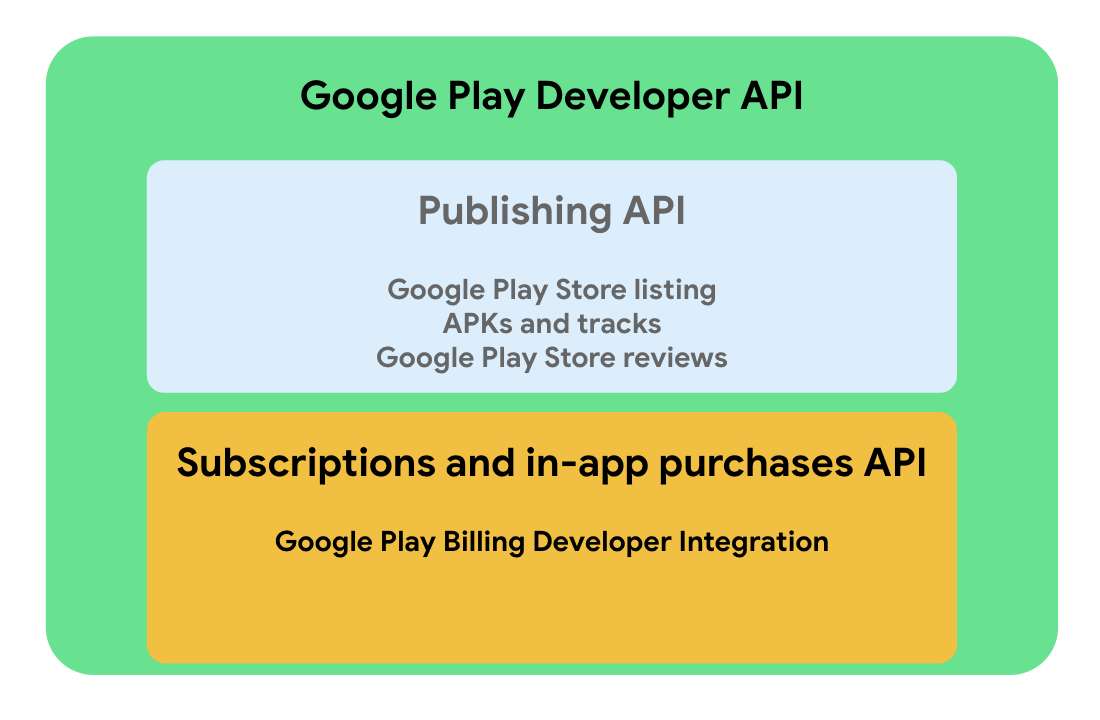Il sistema di fatturazione di Google Play è un servizio che ti consente di vendere contenuti e prodotti digitali nella tua app per Android, indipendentemente dal fatto che tu voglia monetizzare tramite acquisti singoli o offrire abbonamenti ai tuoi servizi. Google Play offre un insieme completo di API per l'integrazione sia con la tua app per Android sia con il backend del server, che consentono agli utenti di usufruire della familiarità e della sicurezza degli acquisti su Google Play.
Architettura di integrazione
Questa sezione illustra i diversi moduli funzionali che puoi creare e le API e le librerie disponibili per semplificare la procedura.

Puoi integrare il sistema di fatturazione di Google Play con la tua app per Android utilizzando la Libreria Fatturazione Google Play. Questa libreria consente la comunicazione con il livello Google Play Services che fornisce l'offerta di prodotti localizzata disponibile per ogni utente nella tua app, nonché metodi per gestire altre operazioni utente necessarie, come l'avvio del flusso di acquisto e la gestione del relativo esito.
Devi anche integrare il sistema di fatturazione di Google Play con il backend del server per creare i flussi necessari per gli sviluppatori. Questo è fondamentale per garantire che la gestione degli acquisti e i diritti multipiattaforma siano efficienti e sicuri. Puoi creare questa integrazione con l'API Subscriptions and In-App Purchases fornita dall'API Google Play Developer. L'integrazione del backend sfrutta anche alcuni strumenti della piattaforma Google Cloud.

Terminologia
Questa sezione elenca e descrive le tecnologie e i concetti di alto livello che potresti riscontrare durante l'integrazione del sistema di fatturazione di Google Play nella tua app. Consulta questo elenco man mano che segui le indicazioni per l'integrazione.
Tecnologie
- Google Play. Un negozio online in cui gli utenti possono scaricare app e altri prodotti digitali.
- Google Play Console. Una piattaforma che fornisce un'interfaccia in cui puoi pubblicare la tua app su Google Play. Google Play Console mostra anche i dettagli della tua app, inclusi eventuali prodotti o contenuti che vendi con Google Play.
- Console Google Cloud. Una piattaforma che gestisce le API di backend, come l'API Google Play Developer.
- Google Play Billing Library. Un'API che puoi utilizzare per integrare il sistema di fatturazione di Google Play nella tua app.
- API Google Play per gli sviluppatori. Un'API REST che puoi utilizzare per gestire in modo programmatico le attività di pubblicazione e gestione delle app.
- Cloud Pub/Sub. Un servizio di messaggistica in tempo reale completamente gestito che consente di inviare e ricevere messaggi tra applicazioni indipendenti. Google Play utilizza Cloud Pub/Sub per inviare notifiche in tempo reale per gli sviluppatori. Per utilizzare Cloud Pub/Sub, devi avere un progetto sulla Google Cloud Platform (GCP) con l'API Cloud Pub/Sub abilitata. Se non hai dimestichezza con Google Cloud e Cloud Pub/Sub, consulta la guida rapida.
- Notifiche in tempo reale per gli sviluppatori. Un meccanismo che consente di monitorare in tempo reale le modifiche dello stato degli abbonamenti gestiti da Google Play sfruttando Cloud Pub/Sub.
- Server di backend sicuro. Nell'ambito dell'integrazione del sistema di fatturazione di Google Play nella tua app, ti consigliamo vivamente di utilizzare un server di backend sicuro per implementare attività correlate alla fatturazione come la verifica degli acquisti, funzionalità specifiche per gli abbonamenti e la gestione delle notifiche in tempo reale per gli sviluppatori.
- App Google Play Store. Un'app che gestisce tutte le operazioni relative a Google Play. Tutte le richieste effettuate dalla tua app vengono gestite dall'app Google Play Store.
Concetti
- Flusso. Un flusso mostra i passaggi tipici di un'attività correlata alla fatturazione. Ad esempio, un percorso di acquisto illustra i passaggi coinvolti quando un utente acquista il tuo prodotto. Un flusso di abbonamento potrebbe mostrare come un abbonamento passa da uno stato all'altro.
- Diritti. Quando un utente acquista un prodotto in-app, ne ha il diritto all'interno della tua app. Per i prodotti una tantum, questo significa che ora l'utente dovrebbe avere accesso permanente al prodotto. Per gli abbonamenti, significa che l'utente deve avere accesso mentre l'abbonamento è attivo.
- ID prodotto. L'ID di un tipo di prodotto specifico.
- Token di acquisto. Una stringa che rappresenta il diritto di un acquirente a un prodotto su Google Play. Indica che un utente Google ha pagato per un prodotto specifico.
- ID ordine. Una stringa che rappresenta una transazione finanziaria su Google Play. Un ID ordine viene creato ogni volta che si verifica una transazione finanziaria. Questa stringa è inclusa in una ricevuta inviata via email all'acquirente. Puoi utilizzare l'ID ordine per gestire i rimborsi nella sezione Gestione ordini di Google Play Console. Gli ID ordine vengono utilizzati anche nei report su vendite e pagamenti.
Passaggi successivi
Per iniziare a integrare il sistema di fatturazione di Google Play con il backend dell'app e del server, consulta la guida alla configurazione.

